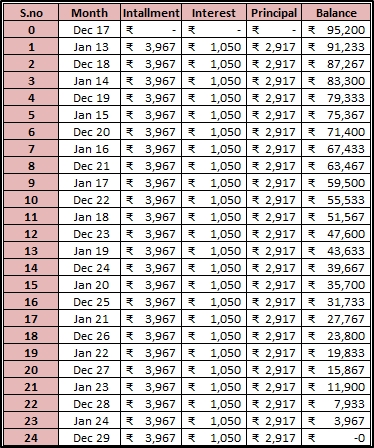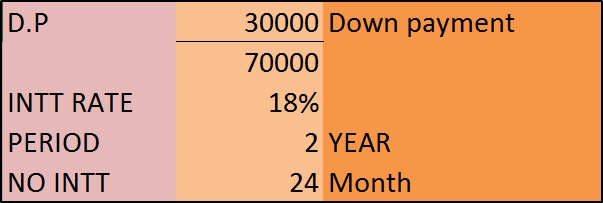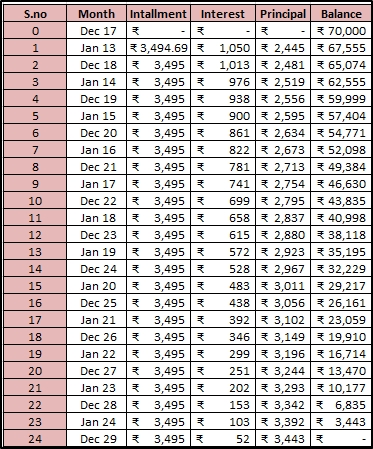Today,
we have a loan for just about everything, be it a house, car, foreign trip and
even a mobile.
The 'loan culture' has caught on in a big way. A majority of people
have availed of loans at some point or the other.
But do we really know how the EMI on the loan
is calculated?
What is an EMI?
An EMI is a
monthly amount paid by the borrower to the lender in order to clear the
outstanding loan amount. A specific sum of pre-decided amount is deducted from
your chosen account, every month without fail. The deduction is not affected by
any sudden financial constraints you may face and will continue to be carried
out by the bank. The EMIs are usually deducted on a fixed date every month
until the tenure of the loan is completed and the whole loan amount is repaid
An Equated Monthly Installment (EMI) is the amount paid by a borrower
each month to a lender of the loan.
The EMI is an unequal combination
of principal (the actual loan you have
taken) and interest rate.
EMI payments are made every month, generally on a fixed date, for
the entire tenure of the loan, till the outstanding amount, has been completely
repaid.
It is important to understand how
banks work out the EMI so that you would find it easier to evaluate various
loan options.
So
how does the bank arrive at the future value of a loan & interest to be
repaid at future dates?
The answer is ‘Time value of money’. The theory of time value of money says that a
rupee receivable today is more valuable than a rupee receivable at a future
date. This is because the rupee received today can be invested to earn
interest. For instance: Rs. 100 receivable today can be invested at, say, 9%
interest and therefore
enables one to earn an additional Rs. 9 in a year.
In
the earlier years of loan repayment, it is mainly the interest payments that
are being made while the principal amount is much less. As
the loan matures, and as the principal gradually gets paid, the outstanding
loan amount reduces. The interest component thus becomes lower than the
principal, and finally minimal.
PAYMENT OPTIONS
FIXED RATE EMI: Fixed rate loans are those which remain the same throughout
the tenure. This can be the best option only when the interest rate has reached the bottom, from where an upward trend is expected.
FLOATING RATE EMI: Floating rates move in tandem with market and RBI
measures which are prone to fluctuation depending on the market and economy.
Does
my EMI stays constant?
Yes.
Though the EMI is an unequal combination of interest rate and principal, it
stays constant. Unless…
Unless:
If you prepay part of the loan, the amount of your remaining EMIs
will not remain the same if you leave the duration of your loan constant.
In case you have taken a floating rate loan, the EMI will change
as the interest rates change. Of course, some have the option of the EMI not
changing but the tenure increasing or decreasing.
You opt for a loan where the EMI keeps increasing over the years.
To give an example, let's say you have a 10-year loan. The EMI stays constant
for three years, then rises for the next three years and rises again for the
last four years. This will help young individuals who cannot afford a huge EMI
at this point but can do so as their earnings rise.
Mathematics Calculation of EMI:
EMIs
for a home loan are calculated using the following mathematical formula:
EMI
= P x r x (1+r) n/((1+r)n-1)
Where,
P = Loan amount
r
= Rate of interest
n
= Loan Tenure (number of months)
The various methods adopted are:
Annual reducing method: A method of calculating interest on the reduced
principal at the end of every year. However, as repayments for all loans are
EMI, though the principal is reduced every month, the interest is calculated on
the original loan amount for twelve months after which the repayments towards a principal is taken into account. Basically, this method will benefit you the
least.
METHOD OF COMPUTATION
Monthly reducing loans: This is a better and easy to understand the method of EMI calculation and is usually the most common calculation method
adopted. In this calculation methodology, there is a reduction in principal with
EMI being paid every month. The interest is calculated on the outstanding
balance.
Daily reducing loans: In this method, the principal reduces every
day, with daily loan repayments. The interest is charged on the outstanding
balance. However, daily EMI payment is not a very feasible option.
PRE-EMI
AND ADVANCE DISBURSEMENTS (Relevant in case of a home loan)
There
are instances where the borrower may opt for a partial disbursement of their
home loan on the basis of the stages of construction of
their house. In such cases, a pre-EMI is to be paid every month until the final
loan is disbursed. The real loan repayment would commence only after the entire a loan is disbursed. This pre-EMI would, therefore, comprise only the interest
accrued on the disbursed money.
Also,
there are cases when the entire loan may be disbursed by lenders before the
completion of house construction. This is known as an advance disbursement and
is undertaken by the lender when it is requested by the borrower
and the lender is convinced of the capabilities of the builder to complete the
construction work in time. In these cases, the EMI payment starts immediately
from the date of disbursement.
The benefit of an EMI for borrowers
is that they know precisely how much money they will need to pay toward their
loan each month, making the personal
budgeting process easier.
The formula for EMI (in arrears) is
where: P is the
principal amount borrowed, A is the periodic amortization payment, r is the periodic interest
rate divided by 100 (annual interest rate also divided by 12 in case of monthly
installments), and n is the total number of payments (for a
30-year loan with monthly payments n = 30 × 12 = 360).
For example, if you borrow 10,000,000
units of a currency from the bank at 10.5% annual interest for a period of 10
years (i.e., 120 months), then EMI = Units of currency 10,000,000 * 0.00875 *
(1 + 0.00875)^120 / ((1 + 0.00875)^120 – 1) = Units of currency 134,935. i.e.,
you will have to pay total currency units 134,935 for 120 months to repay the
entire loan amount. The total amount payable will be 134,935 * 120 = 16,192,200
currency units that includes currency units 6,192,200 as interest toward the
loan.
Example
Flat Method
 |
| Flat Method |
 |
| Flat Method |
2) REDUCING METHOD
A) Installment = -PMT(Interest Rate/12,No.of.Installment,Finance Amount)
B)Principal = -PPMT(Interest Rate/12,Serial No,No.of.Installment,Finance Amount)
C)Interest = -IPMT(Interest Rate/12,Serial No,No.of.Installment,Finance Amount)
Above Formula Can use in M.S.Excel












0 Comments